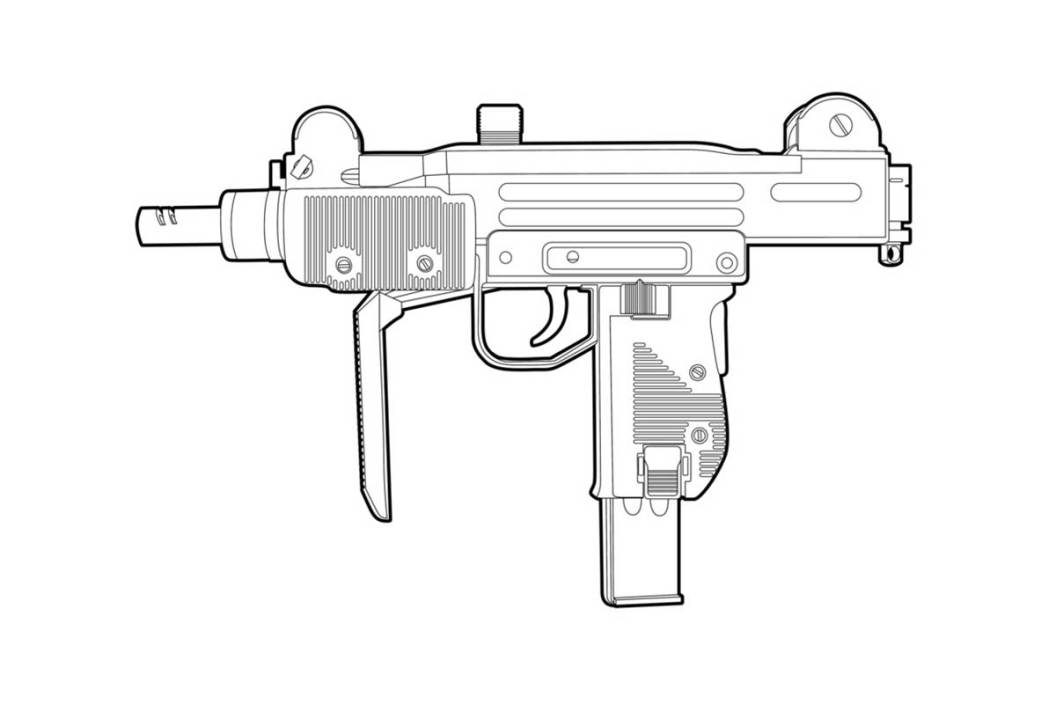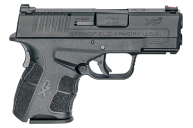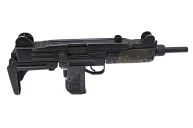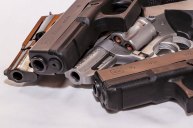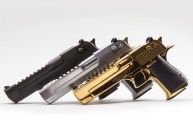These firearms belong in the nostalgia pile with Miami Vice suits and DayGlo Trapper Keepers.
There are some guns that, on sight, conjure up a steady synth beat in one's head. Usually they're associated with some super popular movie or show from the 1980s. Some guns were simply everywhere in the pop culture of the time. It was all about the first wonder nine handguns and updated submachine guns that used modern production methods and materials.
The '80s was a time of really interesting firearms innovation and you can see that in the guns became part of the cultural landscape, for one reason or another.
Here are some of the guns that just scream "The Eighties!"
The Infamous TEC-9
This gun is now more known for being infamous than anything else, and it scared the crap out of non-gun people perhaps more than any gun on this list when it first hit the market.
Why? When the TEC-9 was introduced, the semi-automatic blowback pistol caught heat from the ATF because they said its simple construction of stamped and milled steel parts, along with the fact that it fired from an open bolt, made the gun too easy to illegally convert to full-auto. Coupled with a low price because of its simple production, and the gun was demonized out of the gate. Its manufacturer, Intratec, almost sold it to the South African apartheid government, which didn't do wonders for the gun's PR either.
When the TEC-9 was brought to the U.S. as an open-bolt semi-auto pistol, it was redesigned to eliminate its original collapsible stock and vertical foregrip so it would comply with NFA rules, but you still saw these features in movies. More ATF squawking forced a redesign and the introduction of the closed-bolt KG-99, which ultimately came to market.
In Hollywood, it often doubled for the TEC-9 and the KG-99 made a bunch of appearances on Miami Vice. For the show, armorers converted it to a legal machine gun, so naturally everyone thought TEC-9s were all full auto. It went on to make appearances in a whole lot of movies and TV shows, almost always as a bad guy's gun.
By the late eighties the TEC-9 had gained a reputation as being a favorite gun of gangs because of its low price, high capacity magazines, and its perceived ability to be converted to full auto. As such, it was subsequently banned in several states and was also banned by name, along with 18 other firearms, in the Federal Assault Weapons Ban of 1994.
In response, Intratec stopped making both the TEC-9 and the KG-99 and began producing the smaller DC9 pistol, with no threaded muzzle, no barrel shroud, and a 10-round magazine—though it still accepted the larger pre-ban 20- and 32-round mags.
Over 250,000 TEC-9s and its variants were ultimately produced and sold worldwide.
The Bullpup Steyr AUG
The bullpup Austrian Steyr AUG was actually introduced in the late '70s, but in the '80s, it was THE gun to use in a movie if you wanted something futuristic looking. Heck, filmmakers did that for about 30 years or so. The AUG was designed as an Austrian assault rifle chambered for 5.56 NATO and was adopted by the Austrian Army in '78 as the StG 77. The gun was imported into the U.S. in the early '80s as the AUG/SA (the SA stood for semi-automatic).
The unique-looking gun was one of the first widely accepted and popularized bullpup rifles and famously showed up in Die Hard as Karl's long gun of choice. In 1989, the AUG was banned via executive order as part of the 1989 Assault Weapon Import Ban. About six years later, cosmetic changes to the AUG carbine allowed it to be imported again, until the ban expired in 2004, allowing Steyr to import the AUG once again.
The Franchi SPAS-12 Shotgun
This has to be the most popular movie shotgun of the '80s and '90s. The Franchi SPAS-12 scattergun was unique in both its mean looks and for the impressive fact that it could be operated as a pump action or semi-auto shotgun. It was built for law enforcement and the idea was that it could be used in semi-auto with buckshot combat rounds, and the pump action could be used for low powered breeching and less-lethal ammunition that wouldn't be able to cycle the gun in semi-auto. A simple switch on the bottom of the slide handle controlled the firing mode.
This gun showed up everywhere in the '80s with its distinctive folding stock, sometimes with the arm hook, sometimes shown without. Arnold used one without a stock at all in The Terminator (1984), and fired it one handed along with a Colt AR-18 in the other hand during the police station shootout.
Parts of the SPAS-12 were mated with a Remington 870 to create the "grenade launcher" on the bottom of the M41A Pulse Rifle in Aliens (1986). The shotgun got its biggest starring role as the standard park personnel firearm in the original Jurassic Park (1993), including a detailed view of the folding stock at work during the famous raptor scene.
Beretta 92 FS Pistols
If Dirty Harry's Smith & Wesson Model 29 was THE pop culture law enforcement gun of the '70s, then that title definitely goes to the Beretta 92 for the '80s. The U.S. military replaced the M1911A1 with the pistol, designated as the M9, in 1985. In Hollywood, fictional cops were getting ahead of the curve by carrying the Beretta 92FS before many departments later adopted it in real life, including the LAPD.
NYPD Det. John McClane (Bruce Willis) carried one in Die Hard (1988) (actually he carried a slightly earlier but nearly identical 92F in the first movie) and LAPD Sgt. Martin Riggs (Mel Gibson) carried one in Lethal Weapon (1987), where the gun got a little love letter in the dialog when it's described by Riggs' new partner. The burst-fire variant, the Beretta 93R, was used as the base for the famous and fictional Auto-9 pistol in Robocop (1987) and the pistol and its variants have appeared in countless movies and TV shows. By the '90s, the gun had become so commonplace that its silhouette was the "R" the logo for HBO's The Sopranos.
While it's not technically a "wonder nine" since it has a steel frame and not a polymer one, the 92FS represented a big change in how handguns were viewed by the military, police, and the general public. Instead of six-shot .38s or single-stack .45s that only held seven or eight rounds, the Beretta held 15-rounds of 9mm in its double-stack magazine. Instead of "knock down power" that capacity and round count meant a greater emphasis on volume of fire and shot placement—in theory. A typical load-out for the Beretta with a mag in the gun and two spare mags increased overall capacity to 45 rounds, compared to 24 rounds with 8-round 1911 mags, and 18 rounds with a revolver and two speedloaders. That's a big difference.
John Browning's Hi-Power 9mm pistol had the same capacity, but it came along a bit too early, though some unconventional real-life police officers carried a Hi-Power. On the fictional side, Axel Foley (Eddie Murphy) used a Hi-Power instead of a Beretta in Beverly Hills Cop (1984) and Beverly Hills Cop II (1987).
In the movies it just meant actors got away with firing never-ending handgun magazines, because everyone counts to six, but nobody counts to 15.
The Uzi
The Uzi submachine gun is about as '80s as it gets. The word "Uzi" came to mean any small full-auto firearm with a high rate of fire to the general public. It conveyed a sense of extreme firepower and, to many people, overkill.
Israeli Defense Forces (IDF) began using the Uzi in the 1950s, but it wasn't until 1980 that the submachine gun was imported into the U.S. as a carbine with a 16-inch barrel, a closed bolt, and only able to fire in semi-auto with a floating firing pin instead of a fixed pin. The Uzi design itself was unique because its telescoping bolt allowed the magazine to be inserted in the pistol grip like a handgun instead of a magwell in front of the trigger.
While you saw the Uzi quite a bit in 1970s movies, usually in the hands of terrorists, it was on screen constantly in the 1980s. It was carried by a bunch of characters in The Dogs of War (1981) and it showed up in Death Wish 2. It got some healthy screen time in Scarface (1983) and a much bigger role in Arnold's hands in both The Terminator and Commando (1985).
The bad guys used Uzis in the Bond film A View to Kill (1985) and its most famous good guy role came in 1986 when Chuck Norris carried one as Maj. Scott McCoy in The Delta Force. And that's not counting the Micro Uzi, which was used in a slew of other '80s movies.
The U.S. Secret Service gave the Uzi its biggest bit of public exposure in 1981. During an assassination attempt on President Ronald Reagan on March 30, in front of a bunch of cameras, Special Agent Robert Wanko pulled an Uzi from a briefcase he'd been carrying to cover the rear of the presidential limo as it sped off with a wounded Reagan inside. The agency had been using the Uzi since the 1960s, but this was the first time the public got a look at them doing so. The Secret Service continued using the Uzi as their submachine gun until it was replaced by the Heckler & Koch MP5 platform in the 1990s and later the FN P90.
NEXT: TACTICAL HANDGUNS: CHARACTERISTICS, FEATURES, AND A FEW SUGGESTIONS
